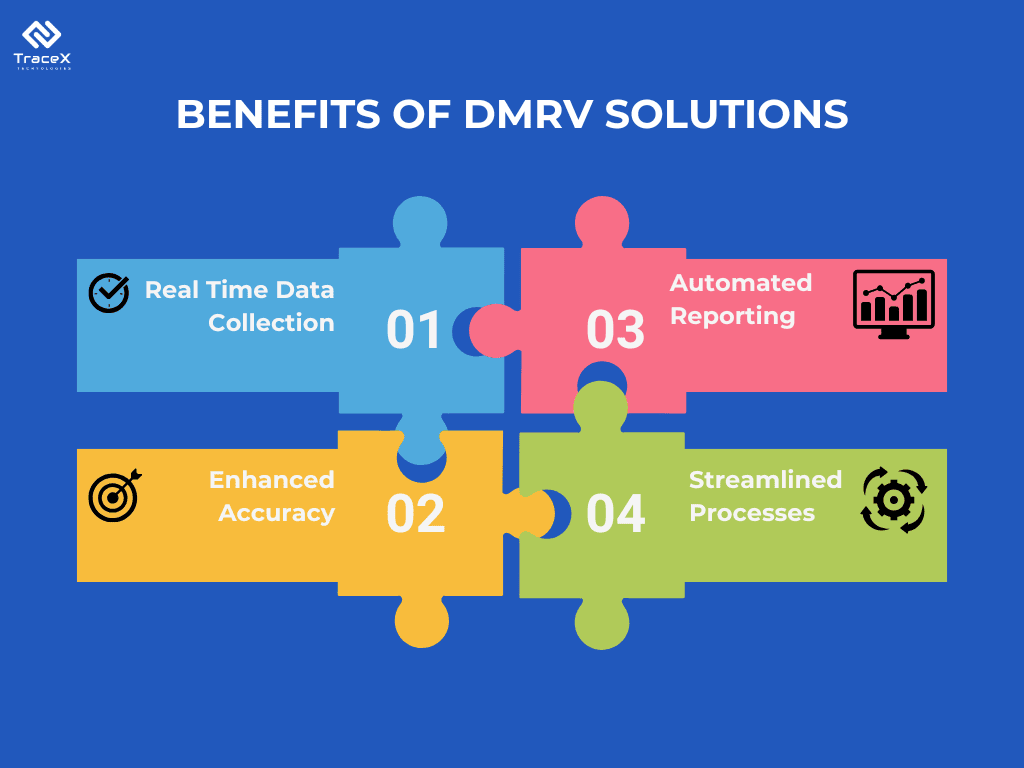Contact: +91 99725 24322 |
Menu
Menu
Quick summary: Discover how Digital MRV solutions streamline carbon credit verification, making the process faster, accurate, and transparent for project developers, sustainability leaders, and verification bodies.

Accurate carbon measurement is key. To But how do we ensure that these measurements are trustworthy? This is a common question for many project developers. Traditional methods of monitoring, reporting, and verification (MRV) are often slow, complicated, and costly. For small projects, it can feel like a huge hurdle. That’s where digital MRV solutions come in. They provide a faster, more accurate, and cost-effective way to verify carbon credits, making the process smoother and more transparent.
Digital Monitoring, Reporting, and Verification (DMRV) solutions leverage advanced technologies such as IoT, AI, and blockchain to revolutionize the way carbon credits are tracked and verified. By automating data collection and providing real-time insights, DMRV enhances accuracy and reduces the risk of human error. These solutions streamline the verification process, ensuring that carbon credits genuinely reflect reductions in greenhouse gas emissions.
Key Takeaways
Digital MRV, or Digital Monitoring, Reporting, and Verification, is a way of using advanced tech to simplify how we track and verify carbon emissions. Think of it as a smart system that uses tools like IoT (Internet of Things), AI (Artificial Intelligence), and blockchain to make sure that the process of measuring and reporting carbon credits is as smooth and accurate as possible.
For example, in agriculture, digital MRV might use satellite imagery and remote sensors to monitor how much carbon is being absorbed by crops and soil—like keeping an eye on how well a farm is soaking up CO2. This data can then be analyzed to ensure the numbers are right, without needing as much manual work.
The benefits? With DMRV, you get real-time data, better accuracy, and less chance of mistakes, making it much easier for project developers to verify their carbon credits confidently. It’s like having a digital assistant that keeps track of everything for you!
Traditional carbon credit verification comes with its fair share of challenges, making it tough for many project developers and organizations to navigate smoothly.
Digital MRV solutions are digital monitoring systems that transform the way carbon credit verification works, making it more efficient and accurate.
Digital MRV tools like IoT sensors can collect data in real time. This means instant updates on carbon reduction efforts without having to wait for manual reports. For example, in forestry projects, IoT sensors can track how much CO2 trees are absorbing, providing up-to-date insights that can be used right away.
One of the biggest time-savers with digital MRV is automated reporting. Instead of manually creating reports, the data is automatically processed and presented in a standardized format. This reduces errors and ensures consistency. For project developers, this means they can easily access a dashboard that tracks their project’s progress without the hassle of spreadsheets.
AI comes in handy when dealing with the large datasets that carbon projects generate. It can analyze data quickly, spot any inconsistencies, and make sure only accurate information is used to calculate carbon credits. This means more reliable
Blockchain is like a digital ledger where every data entry can be tracked and verified. This makes the entire verification process transparent and tamper-proof. For example, in renewable energy projects, blockchain can be used to track each carbon credit from its creation to its sale, ensuring that buyers know exactly what they’re purchasing.

Digital MRV means less time spent on tedious data collection and reporting, letting project developers focus more on their core activities. It also reduces costs associated with manual tracking, making projects more profitable
Having accurate, real-time data means sustainability heads can report their achievements with confidence. This ensures that their claims about reducing emissions are backed up by solid data, which is crucial for maintaining trust with stakeholders and customers
Digital MRV simplifies the verification process. Automated data collection and analysis make it easier for verification bodies to assess projects quickly and accurately. Plus, the transparency offered by digital tools like blockchain ensures that all data is reliable, reducing the chance of errors or fraud
Digital Monitoring, Reporting, and Verification (DMRV) solutions greatly benefit environmental NGOs by enhancing data accuracy and transparency in their projects. With real-time monitoring and blockchain integration, these solutions enable NGOs to ensure accountability and build trust with stakeholders.
By making the process smoother for each of these groups, digital MRV helps create a more efficient and trustworthy carbon market.
The TraceX DMRV (Digital Monitoring, Reporting, and Verification) platform is a cutting-edge solution designed to simplify the carbon credit verification process. It helps project developers, sustainability leaders, and verification bodies track, report, and verify carbon reduction activities with greater ease and accuracy. By leveraging advanced technologies like blockchain, IoT, Satellite Imagery ,TraceX ensures that the data is reliable, transparent, and compliant with global standards.
The platform uses blockchain technology to ensure that every data point is secure and tamper-proof. This means that all records related to carbon credits—like emissions reductions, project activities, and monitoring data—are stored in a way that can’t be altered. It’s like having a digital ledger that everyone can trust, providing a clear audit trail for every transaction.
The platform integrates IoT (Internet of Things) devices, like sensors and satellite imagery, to monitor activities in real-time. This real-time data helps project developers stay on top of their carbon reduction progress without needing to rely on manual data collection.”
The platform simplifies the reporting process with automated dashboards and analytics. Instead of manually compiling data, project developers get ready-to-use reports that are compliant with international carbon standards. This feature is especially useful for sustainability heads who need accurate, up-to-date data to support their claims and meet compliance requirements.
The Sustainability Foundation utilizes the TraceX DMRV platform to improve operational efficiency and enhance transparency with partners. By leveraging data-driven insights, they are empowered to accelerate large-scale tree planting initiatives, significantly increasing their environmental impact.
Digital MRV solutions have revolutionized the process of carbon credit verification by making it faster, more accurate, and more transparent. By leveraging technologies like IoT, AI, and blockchain, these solutions address the challenges of traditional verification methods—reducing costs, enhancing data quality, and providing real-time insights. As the demand for credible and verifiable carbon credits grows, adopting digital MRV tools like those offered by TraceX can help project developers and businesses stay ahead, ensuring that their efforts in reducing carbon emissions are properly recognized and rewarded. It’s a step toward a more efficient and trustworthy carbon market, making a significant impact in the fight against climate change.
Digital MRV (Monitoring, Reporting, and Verification) uses advanced technologies like IoT, AI, and blockchain to automate and streamline the tracking of emissions and the verification of carbon credits. It provides real-time data, enhances accuracy, and reduces the costs and complexities associated with traditional verification methods.
Blockchain creates a secure and tamper-proof record of every transaction related to carbon credits. This transparency ensures that data cannot be altered once it’s recorded, making the verification process more trustworthy for project developers, auditors, and buyers.
Real-time data allows project developers to monitor their carbon reduction activities as they happen, making it easier to track progress and make necessary adjustments. This reduces delays in verification and ensures that emission reductions are accurately recorded, making the carbon credits more reliable for buyers.
